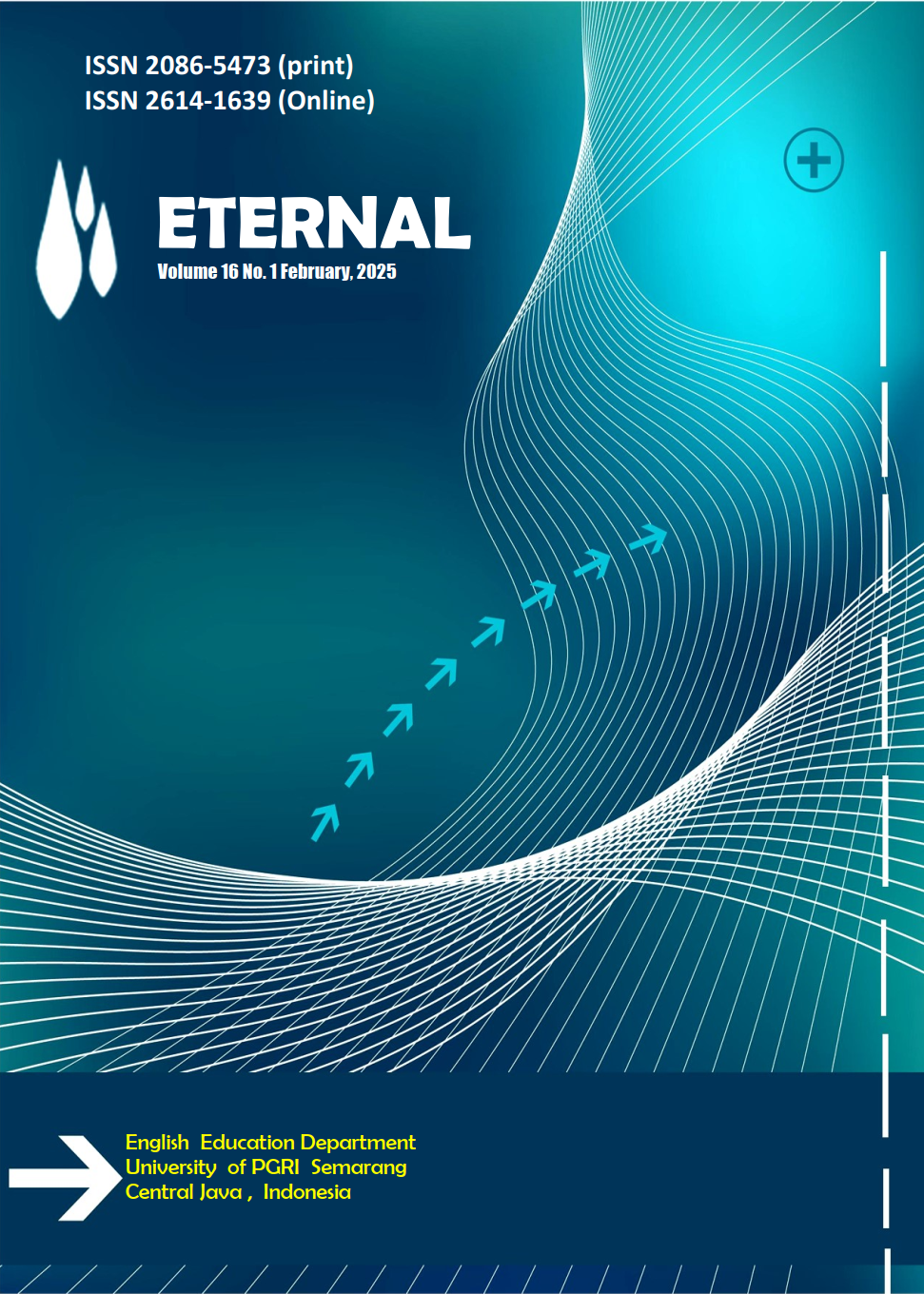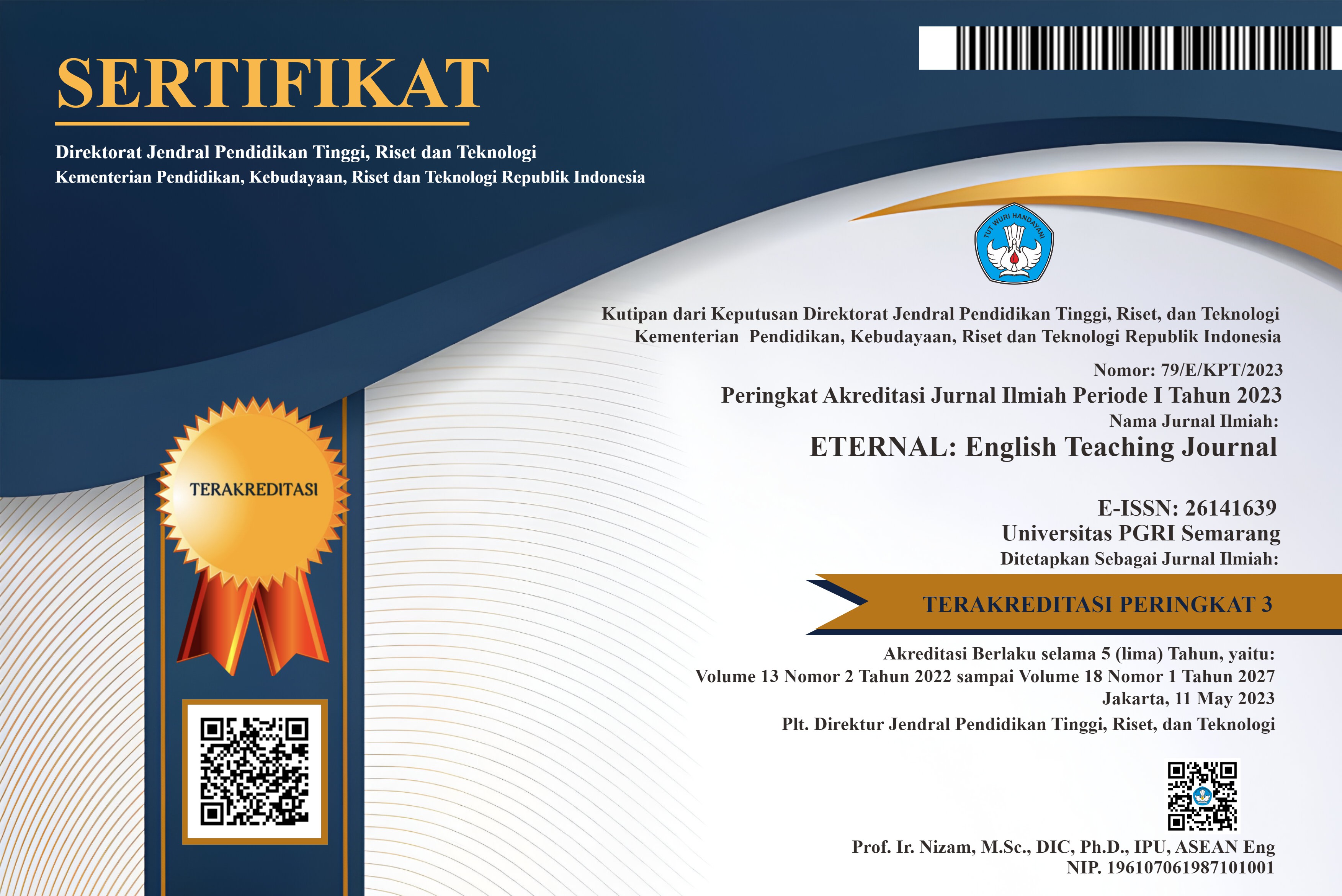Unveiling Halliday’s Textual Metafunction in Indonesian and Samoan EFL Textbooks for Year 10
DOI:
https://doi.org/10.26877/eternal.v16i2.1613Keywords:
EFL Textbooks, reading passages, rheme, theme, thematic progressionAbstract
Abstract. Textual metafunction helps the authors develop text coherently and cohesively and significantly aids readers in understanding the idea, especially in EFL textbooks. EFL textbook has become the essential learning material in EFL classrooms which it should be delivered with clarity to fostered students to grasp the material. Due to the crucial role of EFL textbooks in EFL classrooms, this study aims to unveil how theme-rheme and thematic progression occurred in reading passages of Indonesian and Samoan EFL textbooks. To attain the aims of the study, twelve reading passages from the Indonesian EFL textbook and eight reading passages from the Samoan EFL textbook for year ten were examined. Data that has been examined by theme-rheme proposed by Halliday and Matthiessen (2014) revealed that topical theme is a common type of theme found in Indonesian and Samoan EFL textbooks. Concurrently, these textbooks have the same type order in the occurrence of theme-rheme’s type, from the most common to the least type of theme that appeared. However, the Samoan EFL textbook contains a smaller variety of components in theme types due to the limited text genres in it. After examined thematic progression of these textbooks, and it revealed that the zigzag theme pattern was the majority theme pattern. Alongside the zigzag theme pattern becoming the majority pattern, these textbooks had different order for the second and third place of theme pattern due to the various contents of these EFL textbooks. This study provides textual metafunction, especially theme-rheme and thematic progression, which could be analyzed in EFL textbooks and, eventually, in literary texts.
References
Al Otaibe, M. (2021). A systemic functional linguistics analysis of technical written texts produced by undergraduate Saudi engineering students. International Journal of Applied Linguistic Studies, 10(1), 1–10. https://doi.org/10.54203/scil.2021.ijals1
Betham-Scanlan, D. (2022). The need for change in curriculum to enhance progress in English learning in Samoa. Journal of Samoan Studies, 12.
Coleman, H. (2010). The English Language in Development . British Council.
Dashela, T. (2021). The analysis of theme and rheme in short story of Sleeping Beauty with a systemic functional approach. SALEE: Study of Applied Linguistics and English Education, 2(1). https://doi.org/10.35961/salee.v2i01.201
Derakhshan, A. (2024). ‘Should textbook images be merely decorative?’: Cultural representations in the Iranian EFL national textbook from the semiotic approach perspective. Language Teaching Research, 28(1), 79–113. https://doi.org/10.1177/1362168821992264
Eggins, S. (2004). An Introduction to Systemic Functional Linguistics. Pearson Education, Inc.
Fatoni, N. R., Santosa, R., & Djatmika, D. (2020). Analysis of textual meaning on lyrics of supporter’s chant to support football players in English Premier League. PAROLE: Journal of Linguistics and Education, 10(2), 146–155. https://doi.org/10.14710/parole.v10i2.146-155
Feri, Z. O., Suharsono, S., & Ashadi, A. (2024). Theme-rheme pattern: Its contribution to cohesion and coherence in the students’ research background. REiLA: Journal of Research and Innovation in Language, 6(1), 94–110. https://doi.org/10.31849/reila.v6i1.16281
Fitriati, S. W., & Gayatri, N. M. (2021). Thematic progression in EFL learners’ writing: A literature review. Lingua Cultura, 15(2). https://doi.org/10.21512/lc.v15i2.7645
Gintings, M. F. M. (2020). Promoting students’ writing skill: Genre-based approach in Indonesia EFL context. Lexeme : Journal of Linguistics and Applied Linguistics, 2(1), 31. https://doi.org/10.32493/ljlal.v2i1.6993
Haji, G. (2023). SFL-Based analysis of thematic progression of English graduate personal statements. LLT Journal: Journal on Language and Language Teaching, 26(2), 440–453. https://doi.org/10.24071/llt.v26i2.6579
Halliday, M. A. K., & Matthiessen, C. (2014). An Introduction to Functional Grammar. In An Introduction to Functional Grammar. https://doi.org/10.4324/9780203783771
Hendrawan, W., Sujatna, E. T. S., Krisnawati, E., & Darmayanti, N. (2021). Thematic progression in uncovering paragraph coherence: Some evidences in Indonesian Secretarial Academy context. TESOL International Journal, 16(1).
Hernandez, H. P. (2020). Comparative analysis of the textual resources in academic texts in Philippine and American englishes from systemic functional linguistic perspective. Journal of English as an International Language, 15(1).
Hoang, V. Van. (2021). “Metafunctions of language” in systemic functional linguistics: A framework for the interpretation of meaning of text in social context. VNU Journal of Foreign Studies, 37(4). https://doi.org/10.25073/2525-2445/vnufs.4750
Ibáñez, R., Moncada, F., & Cárcamo, B. (2019). Coherence relations in primary school textbooks: Variation across school subjects. Discourse Processes, 56(8), 764–785. https://doi.org/10.1080/0163853X.2019.1565278
Jing, W. (2015). Theme and thematic progression in English writing teaching. Journal of Education and Practice, 6(21).
Jusoh, W., Sakinah, W. N. A., Jobar, N. A., Yusoff, M., & Nizam, M. Z. (2022). What is thematic progression in students’ essay? Revision of systematic literature review. International Journal of Academic Research in Progressive Education and Development, 11(4). https://doi.org/10.6007/ijarped/v11-i4/16090
Larasati, K. D., I Gusti Ayu Vina Widiadnya Putri, & Putu Nur Ayomi. (2022). Analysis on thematic progression patterns of Boris Johnson’s Speech. ELYSIAN JOURNAL : English Literature, Linguistics and Translation Studies, 2(4), 100–109. https://doi.org/10.36733/elysian.v2i4.4400
Leong, A. P. (2022). Thematic and rhematic progression in scientific writing: A pilot study. Journal of Language and Literature, 22(1), 238–254. https://doi.org/10.24071/joll.v22i1.4117
Lo Bianco, J. (1990). Samoa Language in bilingual classrooms-Samoa as an example.
Mahfud, A., Rusmawaty, D., Ventje, &, & Kalukar, J. (2024). Theme and rheme analysis in Kurikulum Merdeka English textbook of junior high school. Berumpun: International Journal Of Social, Politics, and Humanities, 7, 2024. https://doi.org/10.33019/berumpun.v4i2.146
Mckee, A. (2001). A beginner’s guide to textual analysis. Metro Magazine.
Meiarista, K., & Widhiyanto. (2020). Theme-Rheme configuration in recount texts produced by Indonesian EFL students. Journal of English Language Teaching, 6(1). https://doi.org/10.15294/elt.v9i1.37148
Ningsih, H. K., & Gunawan, W. (2019). Recontextualisation of genre-based pedagogy: The case of Indonesian EFL classrooms. Indonesian Journal of Applied Linguistics, 9(2), 335–347. https://doi.org/10.17509/ijal.v9i2.20231
Pasaribu, N. P. W. (2023). Thematic progression on a news text entitled “Health ministry ensures no data leak in Pedulilindungi app” from the Jakarta Post. English Journal Literacy Utama, 7(2). https://doi.org/10.33197/ejlutama.v7i2.172
Pavavijarn, S. (2022). Influences of thematic progression on quality of EFL argumentative writing. LEARN Journal: Language Education and Acquisition Research Network, 15(1).
Qomariah, N. (2021). Theme and rheme in students’ writing. KnE Social Sciences, 502–515. https://doi.org/10.18502/kss.v5i4.8707
Radić-Bojanić, B., & Topalov, J. (2016). Textbooks in the EFL classroom: Defining, assessing and analyzing. Zbornik Radova Filozofskog Fakulteta u Pristini, 46–4, 137–153. https://doi.org/10.5937/zrffp46-12094
Siahaan, E. M., Amalia, R. M., & Krisnawati, E. (2023). Type of themes and thematic progression patterns in low achiever’s descriptive writings. Diksi, 31(1). https://doi.org/10.21831/diksi.v31i1.59734
Silaban, W. Y., Lestari, M., Desi, W., Barumbu, N., Kawet, K., Yosua, Sunkudon, A., Darmawan, & Winoto, E. (2023). History of English become an international language. International Journal of Multicultural and Multireligious, 10. https://doi.org/10.18415/ijmmu.v10i2.4359
Sun, X. (2022). Thematic progression and discourse analysis. Academic Journal of Humanities & Social Sciences, 5(15). https://doi.org/10.25236/ajhss.2022.051510
Tarigan, N. B., Sinar, T. S., Harefa, Y., & Yusuf, M. (2020). Markedness of theme in Everything, Everything movie dialog. CaLLs (Journal of Culture, Arts, Literature, and Linguistics), 6(2). https://doi.org/10.30872/calls.v6i2.2332
Thompson, G. (2013). Introducing functional grammar. Routledge. https://doi.org/10.4324/9780203431474
To, V. (2018). Thematic structure in reading comprehension texts in English textbooks. International Journal of Languages, Literature and Linguistics, 4(1), 45–51. https://doi.org/10.18178/IJLLL.2018.4.1.148
Umiyati, M. (2019). Textual metafunction in Donald Trump’s speech “Recognizing Jerusalem as Israel’s Capital.” International Journal of Systemic Functional Linguistics, 2(2). https://doi.org/10.55637/ijsfl.2.2.1321.55-60
Weninger, C., & Kiss, T. (2013). Culture in English as a foreign language (EFL) textbooks: A semiotic approach. TESOL Quarterly, 47(4), 694–716. https://doi.org/10.1002/tesq.87
Xuan, W. W., & Zhang, D. (2023). Understanding textual meaning-making in Chinese high school EFL learners’ writing: A systemic functional perspective. Australian Review of Applied Linguistics, 46(1). https://doi.org/10.1075/aral.20045.xua







